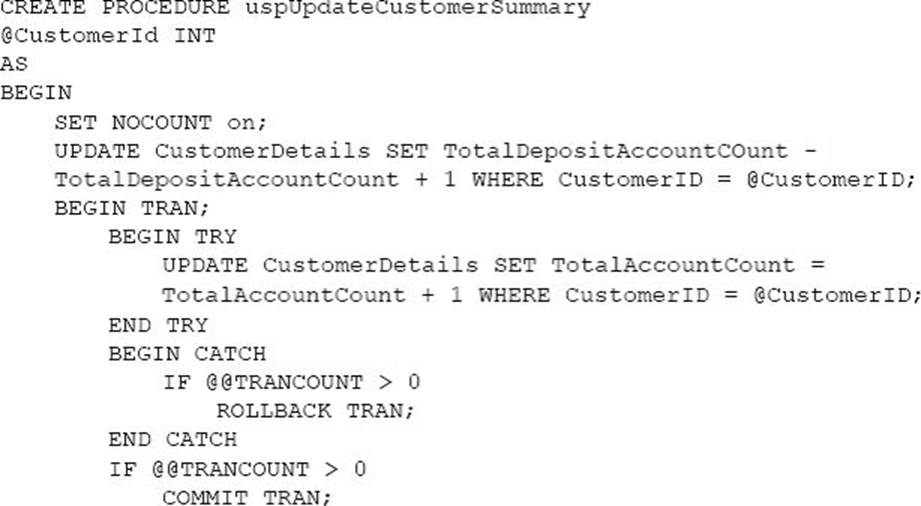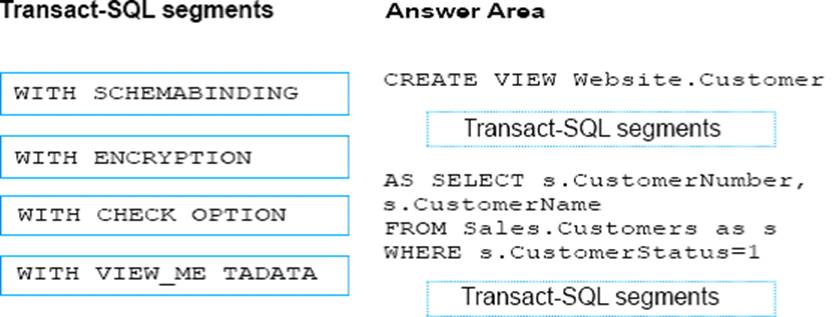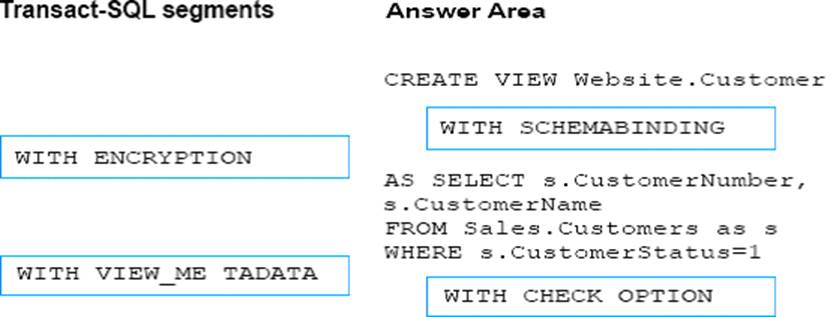Microsoft 70-762 Developing SQL Databases Online Training
Microsoft 70-762 Online Training
The questions for 70-762 were last updated at Feb 15,2025.
- Exam Code: 70-762
- Exam Name: Developing SQL Databases
- Certification Provider: Microsoft
- Latest update: Feb 15,2025
Only allow updates through the views that adhere to the view filter.
You have the following stored procedures: spDeleteCustAcctRelationship and spUpdateCustomerSummary.
The spUpdateCustomerSummary stored procedure was created by running the following Transacr-SQL statement:

You run the spUpdateCustomerSummary stored procedure to make changes to customer account summaries. Other stored procedures call the spDeleteCustAcctRelationship to delete records from the CustomerToAccountBridge table.
You need to create Sales.FemaleCustomers.
How should you complete the view definition? To answer, drag the appropriate Transact-SQL segments to the correct locations. Each Transact_SQL segment may be used once, more than once or not at all. You may need to drag the split bar between panes or scroll to view content.

Only allow updates through the views that adhere to the view filter.
You have the following stored procedures: spDeleteCustAcctRelationship and spUpdateCustomerSummary.
The spUpdateCustomerSummary stored procedure was created by running the following Transacr-SQL statement:

You run the spUpdateCustomerSummary stored procedure to make changes to customer account summaries. Other stored procedures call the spDeleteCustAcctRelationship to delete records from the CustomerToAccountBridge table.
You need to create Sales.FemaleCustomers.
How should you complete the view definition? To answer, drag the appropriate Transact-SQL segments to the correct locations. Each Transact_SQL segment may be used once, more than once or not at all. You may need to drag the split bar between panes or scroll to view content.

Only allow updates through the views that adhere to the view filter.
You have the following stored procedures: spDeleteCustAcctRelationship and spUpdateCustomerSummary.
The spUpdateCustomerSummary stored procedure was created by running the following Transacr-SQL statement:

You run the spUpdateCustomerSummary stored procedure to make changes to customer account summaries. Other stored procedures call the spDeleteCustAcctRelationship to delete records from the CustomerToAccountBridge table.
You need to create Sales.FemaleCustomers.
How should you complete the view definition? To answer, drag the appropriate Transact-SQL segments to the correct locations. Each Transact_SQL segment may be used once, more than once or not at all. You may need to drag the split bar between panes or scroll to view content.

Only allow updates through the views that adhere to the view filter.
You have the following stored procedures: spDeleteCustAcctRelationship and spUpdateCustomerSummary.
The spUpdateCustomerSummary stored procedure was created by running the following Transacr-SQL statement:

You run the spUpdateCustomerSummary stored procedure to make changes to customer account summaries. Other stored procedures call the spDeleteCustAcctRelationship to delete records from the CustomerToAccountBridge table.
You need to create Sales.FemaleCustomers.
How should you complete the view definition? To answer, drag the appropriate Transact-SQL segments to the correct locations. Each Transact_SQL segment may be used once, more than once or not at all. You may need to drag the split bar between panes or scroll to view content.

Only allow updates through the views that adhere to the view filter.
You have the following stored procedures: spDeleteCustAcctRelationship and spUpdateCustomerSummary.
The spUpdateCustomerSummary stored procedure was created by running the following Transacr-SQL statement:

You run the spUpdateCustomerSummary stored procedure to make changes to customer account summaries. Other stored procedures call the spDeleteCustAcctRelationship to delete records from the CustomerToAccountBridge table.
You need to create Sales.FemaleCustomers.
How should you complete the view definition? To answer, drag the appropriate Transact-SQL segments to the correct locations. Each Transact_SQL segment may be used once, more than once or not at all. You may need to drag the split bar between panes or scroll to view content.

Only allow updates through the views that adhere to the view filter.
You have the following stored procedures: spDeleteCustAcctRelationship and spUpdateCustomerSummary.
The spUpdateCustomerSummary stored procedure was created by running the following Transacr-SQL statement:

You run the spUpdateCustomerSummary stored procedure to make changes to customer account summaries. Other stored procedures call the spDeleteCustAcctRelationship to delete records from the CustomerToAccountBridge table.
You need to create Sales.FemaleCustomers.
How should you complete the view definition? To answer, drag the appropriate Transact-SQL segments to the correct locations. Each Transact_SQL segment may be used once, more than once or not at all. You may need to drag the split bar between panes or scroll to view content.

Only allow updates through the views that adhere to the view filter.
You have the following stored procedures: spDeleteCustAcctRelationship and spUpdateCustomerSummary.
The spUpdateCustomerSummary stored procedure was created by running the following Transacr-SQL statement:

You run the spUpdateCustomerSummary stored procedure to make changes to customer account summaries. Other stored procedures call the spDeleteCustAcctRelationship to delete records from the CustomerToAccountBridge table.
You need to create Sales.FemaleCustomers.
How should you complete the view definition? To answer, drag the appropriate Transact-SQL segments to the correct locations. Each Transact_SQL segment may be used once, more than once or not at all. You may need to drag the split bar between panes or scroll to view content.

Only allow updates through the views that adhere to the view filter.
You have the following stored procedures: spDeleteCustAcctRelationship and spUpdateCustomerSummary.
The spUpdateCustomerSummary stored procedure was created by running the following Transacr-SQL statement:

You run the spUpdateCustomerSummary stored procedure to make changes to customer account summaries. Other stored procedures call the spDeleteCustAcctRelationship to delete records from the CustomerToAccountBridge table.
You need to create Sales.FemaleCustomers.
How should you complete the view definition? To answer, drag the appropriate Transact-SQL segments to the correct locations. Each Transact_SQL segment may be used once, more than once or not at all. You may need to drag the split bar between panes or scroll to view content.

Only allow updates through the views that adhere to the view filter.
You have the following stored procedures: spDeleteCustAcctRelationship and spUpdateCustomerSummary.
The spUpdateCustomerSummary stored procedure was created by running the following Transacr-SQL statement:

You run the spUpdateCustomerSummary stored procedure to make changes to customer account summaries. Other stored procedures call the spDeleteCustAcctRelationship to delete records from the CustomerToAccountBridge table.
You need to create Sales.FemaleCustomers.
How should you complete the view definition? To answer, drag the appropriate Transact-SQL segments to the correct locations. Each Transact_SQL segment may be used once, more than once or not at all. You may need to drag the split bar between panes or scroll to view content.

Only allow updates through the views that adhere to the view filter.
You have the following stored procedures: spDeleteCustAcctRelationship and spUpdateCustomerSummary. The spUpdateCustomerSummary stored procedure was created by running the following Transacr-SQL statement:
You run the uspUpdateCustomerSummary stored procedure to make changes to customer account summaries. Other stored procedures call the spDeleteCustAcctRelationship to delete records from the CustomerToAccountBridge table.
When you start uspUpdateCustomerSummary, there are no active transactions. The procedure fails at the second update statement due to a CHECK constraint violation on the TotalDepositAccountCount column.
What is the impact of the stored procedure on the CustomerDetails table?
- A . The value of the TotalAccountCount column decreased.
- B . The value of the TotalDepositAccountCount column is decreased.
- C . The statement that modifies TotalDepositAccountCount is excluded from the transaction.
- D . The value of the TotalAccountCount column is not changed.
Latest 70-762 Dumps Valid Version with 157 Q&As
Latest And Valid Q&A | Instant Download | Once Fail, Full Refund


